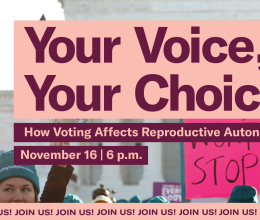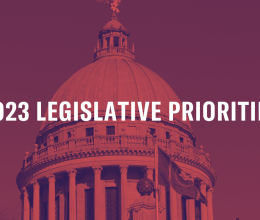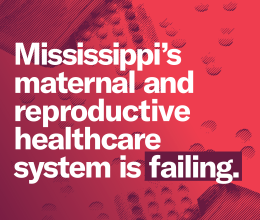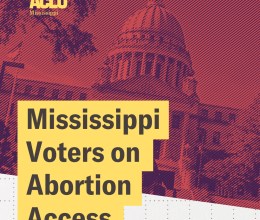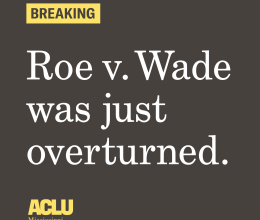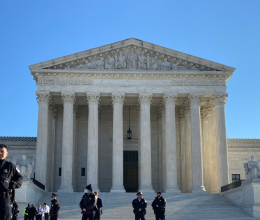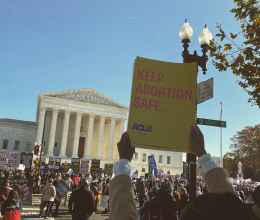Mississippi lawmakers have done nothing to improve access to reproductive healthcare.
An overwhelming majority of Mississippians agree that the current state legislature is failing to invest in the well-being of women and children. Following the U.S. Supreme Court decision in Dobbs v. Jackson Women’s Health Organization to overturn Roe v. Wade, Mississippi’s reproductive healthcare has become even more inaccessible, unaffordable, and nearly obsolete.
Limited abortion exceptions and the loss of Jackson Women’s Health Organization will force many Mississippi women to carry an unwanted pregnancy to term. Current estimates place the number of additional births at 5,000 – a number for which state officials admit they are vastly unprepared.
Read Mississippi's Failure: Maternal and Reproductive Healthcare
With one of the highest maternal mortality rates not just in the United States but across all developed nations, Mississippi is already an inherently dangerous place to give birth.
Between 2013 and 2016, the average maternal mortality rate in Mississippi was 33.2 deaths per 100,000 live births – almost twice as high as the national average. Unsurprisingly, racial disparities in Mississippi’s maternal mortality are just as prevalent. The maternal mortality rate for Black women is nearly three times that of white women–51.9 deaths per 100,000 live births compared to 18.
Mississippi also has the highest poverty rate for women in the nation overall (20 percent compared to the 12 percent national average), and the poverty rate for Black women in the state is almost three times that of white women.
In fact, a large portion of Mississippi women and children live in poverty without adequate access to healthcare and reproductive services.
Black women frequently lack the financial means to access reproductive healthcare.
Just in 2016, 21.9% of Mississippi women aged 18 and older were in poverty, with nearly a third of Black women residents in poverty. While insurance coverage has improved since 2010 (when over a quarter of all Mississippi women between 15 and 44 were uninsured) about one in six women of childbearing age are still uninsured over a decade later.
Without insurance coverage, a pregnant person seeking an abortion, can expect to spend about $500 to almost $1200 for the procedure, depending on the age of the pregnancy at the time of termination. The average abortion patient is already a mother and has a low income, meaning she must stretch her limited means to not only cover the abortion but also provide for childcare during her trip to the clinic, particularly in states with a 24 hour waiting period.
With so many women having lower incomes and a lack of financial opportunities, Medicaid has played a critical role to ensure women in our state receive healthcare during pregnancy and beyond.
Mississippi’s government has limited healthcare options to prevent pregnancy, and ultimately, a pregnancy-related death.
Mississippi has an exception for abortions performed when a pregnancy threatens a mother’s life, but the statute itself is vague and doctors so far have received no guidance from state officials on when and if they may make these judgment calls without risk of prosecution. The state’s largest trauma center, the University of Mississippi Medical Center, has yet to release any information on how it will determine which pregnancies qualify as life-threatening and how it will protect physicians from criminal charges.
While the University of Mississippi Medical Center does have a maternal medicine fellowship for doctors, no family planning fellowship, which has traditionally focused on termination, exists in the state. Not to mention, even with Medicaid coverage, women are expected to cover their own expenses for termination. This is because the “Hyde Amendment” limits using federal funds only to terminate pregnancies arising from rape or incest, or when the pregnancy poses a risk to the patient’s life.
Rural Mississippi women will face even greater risk without access to an in-state facility and physicians that specialize in terminating pregnancies.
As of 2021, over half of Mississippi’s nearly three million residents live in a rural area. According to a 2019 report, 31 of the 64 hospitals that service this population are at high risk of closing. This means that “the most medically underserved state” is poised to lose even more physicians and further place Mississippians at medical risk simply because they are not close enough to a provider.
The closest abortion provider to Jackson is in Columbus, Georgia – an almost six hour drive away – which, for many pregnant people, will not be an option. Georgia’s current state laws prohibit abortions after six weeks, a time period in which few women know they are pregnant, and require a 24 hour waiting period between appointments to receive an abortion.

